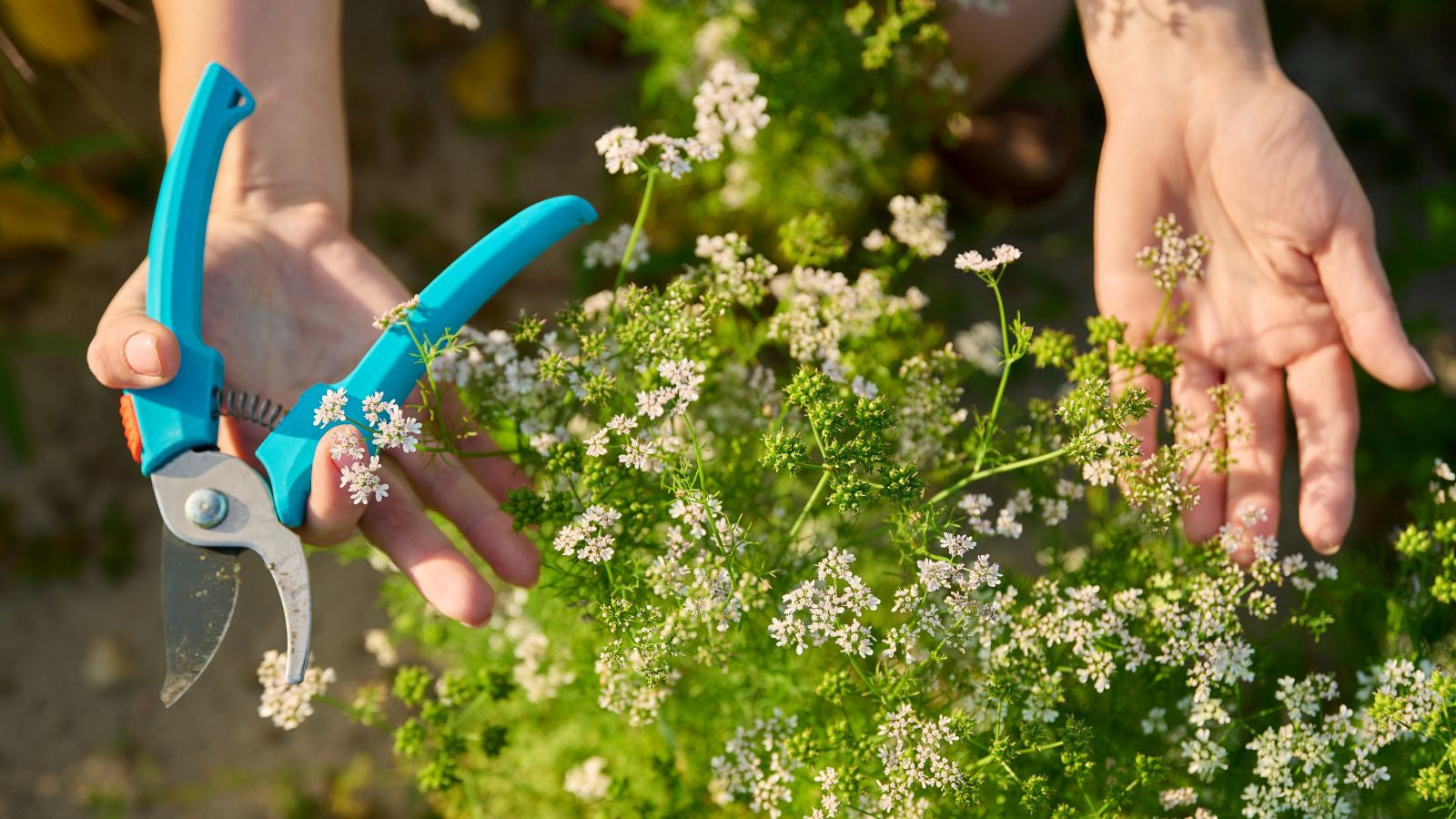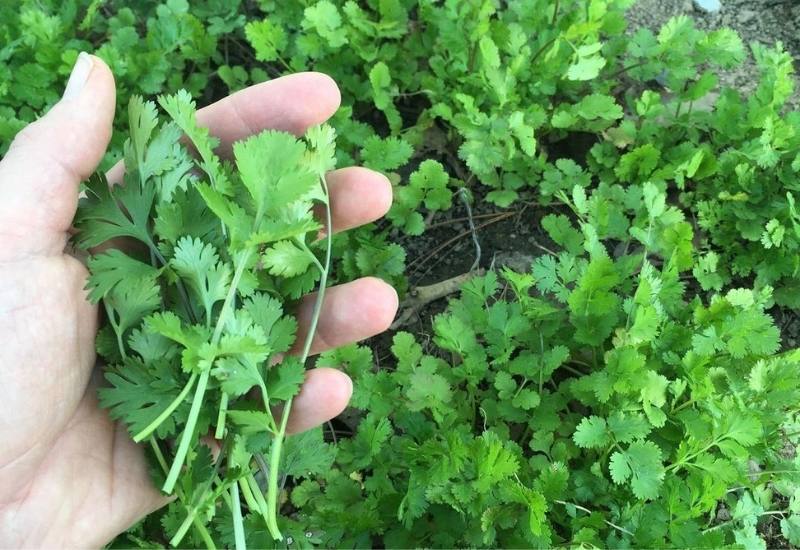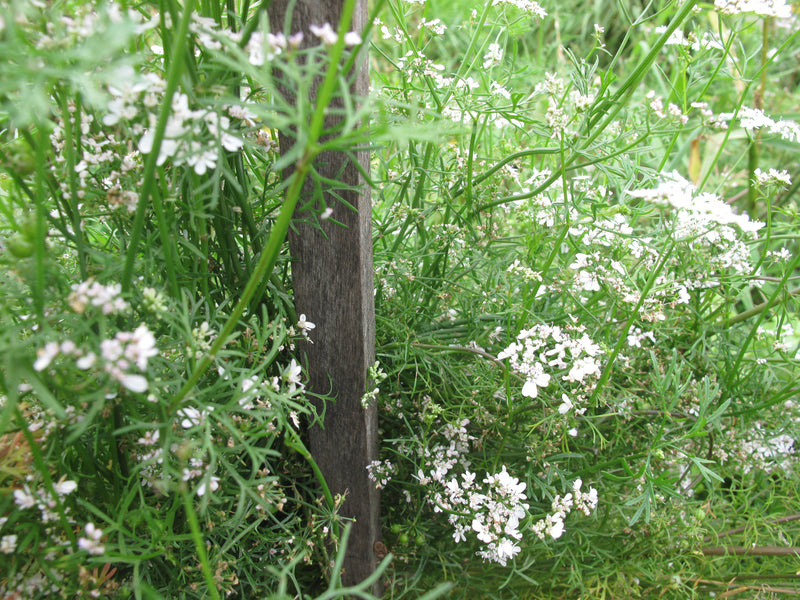Introduction: Cilantro The Herb We Love to Hate
After 20 years of helping gardeners at DH Garden Centre and designing edible landscapes around Vancouver, I can confidently say this: growing cilantro frustrates more people than almost any other herb.
Also known as coriander, cilantro is loved for its fresh, zesty flavor. But plant it in your Canadian garden, and one hot afternoon later boom—it bolts. Flowers appear, leaves turn bitter, and your dreams of garden-fresh salsa vanish.
Here’s the truth: it’s not your fault.
Cilantro is a cool-season herb with a short fuse. But with the right timing, care, and harvesting strategy, you can absolutely grow lush, flavorful cilantro even in Canada’s unpredictable weather.
Let me show you how.

But with the right timing, care, and harvesting strategy, you can absolutely grow lush, flavorful cilantro even in Canada’s unpredictable weather.
What Is Cilantro and Why Is It So Hard to Grow?
Cilantro (Coriandrum sativum) is a fast-growing, cool-season annual herb known for pulling double duty in the kitchen: its bright green leaves are called cilantro, while its aromatic seeds are what we know as coriander. Both parts are edible, flavorful, and packed with culinary potential. But in the garden? Cilantro can be downright frustrating unless you understand how it behaves.
Native to the Mediterranean region, cilantro evolved in a climate with mild winters, cool springs, and short summer days. That’s why it thrives best in cool temperatures, consistently moist soil, and moderate light conditions that aren’t always easy to maintain, especially during Canadian summers.
Why Cilantro Bolts So Quickly
Let’s talk about the #1 reason people struggle with growing cilantro: bolting.
Bolting is what happens when a plant decides it’s time to stop making leaves and start making seeds. It sends up a tall flower stalk, the leaves become thin and bitter, and before you know it, your once-lush cilantro plant is past its prime.
Here’s what causes bolting in cilantro:
-
High temperatures: Cilantro is incredibly sensitive to heat. Once the weather climbs above 24°C (75°F), it starts preparing for reproduction.
-
Long daylight hours: In mid-summer, extended daylight signals to the plant that it’s time to flower and set seed.
-
Stress or poor conditions: Irregular watering, crowded roots, or lack of nutrients can push cilantro into survival mode, triggering premature flowering.
Many gardeners make the mistake of planting cilantro in the middle of summer—exactly when conditions are most likely to cause bolting. The result? Disappointment and a bitter taste—literally.
But here’s the good news: with a few timing tricks and smart care, growing cilantro can become one of the most satisfying parts of your garden.

Bolting is what happens when a plant decides it’s time to stop making leaves and start making seeds.
When to Plant Cilantro in Canada
If there’s one thing that makes or breaks your success with growing cilantro, it’s timing. More than soil, more than fertilizer, more than sunlight knowing when to plant cilantro is the single most powerful trick to keeping it leafy, lush, and bolt-free.
Cilantro isn’t like basil or rosemary. It’s a cool-season herb that thrives when the days are shorter and the air is cooler. If you plant it at the wrong time—especially in the peak of summer it will almost certainly bolt before you get a decent harvest.
So, when exactly should you plant cilantro in Canada?
Best Time #1: Early Spring (March to May)
As soon as your soil is workable and daytime temperatures stay above freezing, you can start growing cilantro. In most regions of Canada, this means late March to early May, depending on your zone.
Cilantro prefers soil temperatures between 10–21°C (50–70°F). Planting in early spring gives your cilantro the cool start it loves and ensures vigorous leaf growth before summer heat arrives.
✅ Pro Tip: In raised beds or containers, the soil warms up faster—giving you a head start on spring planting.
Best Time #2: Late Summer to Early Fall (August to Mid-September)
This is one of the most underused windows for growing cilantro—and one of the most successful.
Why? Because as summer fades, daylight shortens and temperatures drop, which naturally slows bolting. Fall-grown cilantro tends to grow more slowly, but the leaves are often more tender, more flavorful, and last longer into the season.
In fact, in milder Canadian climates like Vancouver and the Lower Mainland, cilantro planted in late August or early September can:
-
Thrive through fall
-
Overwinter under mulch
-
And even self-seed naturally the following spring
That’s right your cilantro can become a self-sufficient guest in your garden year after year if timed correctly.

In fact, in milder Canadian climates like Vancouver and the Lower Mainland, cilantro planted in late August or early September
What About Summer?
Here’s the honest truth: June and July are not ideal months for growing cilantro in Canada—unless you’re prepared to give it extra care.
During these hotter months:
-
Provide partial shade, especially in the afternoon
-
Use shade cloth or companion plants to block intense sun
-
Water deeply and regularly to reduce heat stress
-
Choose slow-bolting varieties like ‘Santo’, ‘Calypso’, or ‘Caribe’
Even then, it’s a bit of a gamble. If you’ve struggled with cilantro before, you’ll find it far easier to grow successfully in spring and fall when conditions match what cilantro naturally craves.
Avoid planting cilantro in June or July unless you can provide partial shade and consistent moisture.
Where to Grow Cilantro
In the Garden:
-
Choose a sunny or partly shaded spot.
-
Use well-drained, fertile soil enriched with compost or aged manure.
-
Ensure regular moisture, especially during dry spells.
In Containers:
-
Use deep pots—cilantro develops a taproot.
-
Potting mix should include compost and perlite for drainage.
-
Keep containers out of harsh afternoon sun in summer.

Avoid planting cilantro in June or July unless you can provide partial shade and consistent moisture.
How to Grow Cilantro from Seed
Cilantro hates being transplanted, so always start from seed. Here’s the expert-approved method:
Step-by-Step:
-
Soak Seeds: Optional, but speeds up germination. Soak for 6–12 hours.
-
Direct Sow: Plant seeds ¼ to ½ inch deep, 1 inch apart.
-
Thin Seedlings: Once plants are 2–3 inches tall, thin to 4–6 inches apart.
-
Water Deeply: Encourage root development by watering thoroughly, not frequently.
-
Mulch: Helps regulate soil temperature and retain moisture.
✅ Tip from the field: Use succession planting—sow new seeds every 2–3 weeks—to maintain a steady supply of fresh leaves.
Choosing the Best Cilantro Varieties for Canada
Not all cilantro is created equal. Some varieties bolt faster than others. For Canadian gardeners, I always recommend slow-bolt types:
-
‘Santo’ – compact, slow to flower
-
‘Calypso’ – very slow to bolt, great for containers
-
‘Cruiser’ – productive and flavorful
-
‘Caribe’ – fast-growing and flavorful
At DH Garden Centre, we stock all of the above—specially selected for West Coast conditions.

Cilantro hates being transplanted, so always start from seed
Common Mistakes When Growing Cilantro (And How to Fix Them)
After 20 years of watching thousands of gardens succeed—and some fail—these are the top mistakes I see people make with cilantro:
❌ Planting too late
✅ Solution: Stick to spring and fall for planting.
❌ Inconsistent watering
✅ Solution: Keep the soil evenly moist, especially during germination and hot weather.
❌ Too much sun in summer
✅ Solution: Provide shade or plant in partial shade during July/August.
❌ Harvesting the whole plant too early
✅ Solution: Trim outer leaves regularly and let the plant keep growing.
How to Harvest Cilantro (For Maximum Flavor)
Many people either wait too long or cut cilantro incorrectly.
Here’s how to do it right:
-
Begin harvesting when plants are 4–6 inches tall.
-
Cut outer leaves first, leaving the center to keep growing.
-
Don’t pull the entire plant unless it’s starting to flower.
-
Harvest every few days to encourage more growth and delay bolting.
✅ Pro tip: Regular harvesting is the best way to delay bolting!
What to Do When Cilantro Bolts?
First, don’t panic. Bolting doesn’t mean the end—it’s just a shift in purpose.
Here’s what you can do:
-
Let it go to seed: You’ll get coriander spice to use in cooking.
-
Collect seeds: Save them for next season.
-
Chop the flowers: Some gardeners use cilantro flowers as edible garnishes.
-
Let it self-seed: In fall gardens, this often results in new plants next spring.
Can You Grow Cilantro Indoors?
Absolutely. Here’s what you’ll need:
-
South-facing window or a grow light (minimum 6 hours of light daily)
-
A deep pot for root growth
-
Regular trimming to prevent legginess
-
Maintain cooler indoor temps (18–21°C) if possible
Growing cilantro indoors gives you year-round flavor—but be mindful it still prefers cooler temps.
Companion Plants: Who Grows Well with Cilantro?
Cilantro’s scent can deter some pests. Pair it with:
-
Tomatoes – partial shade can protect cilantro from afternoon heat
-
Spinach and lettuce – all thrive in cooler weather
-
Peas and beans – nitrogen fixers that support leafy herbs
Avoid planting cilantro near fennel or strong-scented herbs like dill—they can stunt each other’s growth.
The Bigger Picture: Why Growing Cilantro Is a Lesson in Patience
Every year, I meet gardeners at DH Garden Centre who say the same thing:
“I gave up on cilantro. It always bolts on me.”
But I always tell them: it’s not about forcing cilantro to grow the way we want. It’s about learning to grow it the way nature intended.
Grow it when it wants to grow, not when it’s convenient. Keep your harvests regular, let it reseed, and see it not just as a leaf, but as part of a bigger cycle.
That mindset shift? It’s what turns gardeners into growers.
Call to Action 🌿
Want to grow cilantro like a pro this season?
Visit us at DH Garden Centre in Kitsilano, Vancouver. We’ve got:
✅ Certified slow-bolt cilantro seeds
✅ Organic soil blends and compost
✅ Expert planting guides—and we’re always happy to chat garden strategy!
📍 3742 West 10th Avenue, Vancouver, BC V6R 2G4
📞 604-929-7335
🌐 dhgardencentre.com
📲 Instagram/Facebook: @dh.garden.centre
Let’s make your garden greener, tastier, and a whole lot more fun to grow.
FAQs About Growing Cilantro
Q1. What’s the best soil for growing cilantro?
Cilantro prefers rich, well-draining soil with a neutral pH (6.2–6.8). Mix compost or worm castings before planting.
Q2. How long does cilantro take to grow?
Cilantro matures in about 45 – 70 days, depending on the variety and weather. You can start harvesting young leaves after 3 weeks.
Q3. Why is my cilantro leggy?
Too little light or planting too close together. Thin seedlings and provide at least 4–6 hours of sunlight.
Q4. Should I fertilize cilantro?
Yes, but lightly. Use a diluted organic liquid fertilizer every 2–3 weeks. Avoid high nitrogen fertilizers they encourage excessive leaf growth and early bolting.
Q5. Can cilantro grow back after cutting?
Yes! If harvested properly (cutting outer leaves only), cilantro will regrow multiple times before bolting


